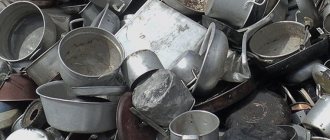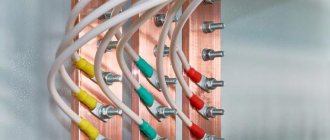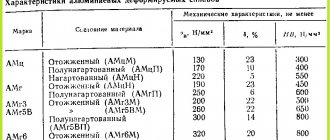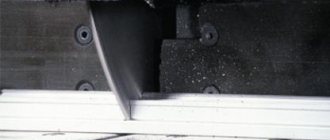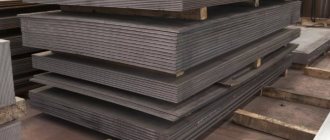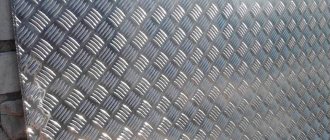Composition and structure of aluminum
Aluminum is the most common metal in the earth's crust. It is classified as a light metal. It has low density and mass. In addition, it has a fairly low melting point. At the same time, it has high ductility and shows good thermal and electrical conductivity characteristics.
Aluminum crystal lattice
Aluminum structure
The tensile strength of pure aluminum is only 90 MPa. But, if you add some substances to the melt, for example, copper and a number of others, then the tensile strength increases sharply to 700 MPa. The same result can be achieved using heat treatment.
Aluminum, which has extremely high purity - 99.99%, is produced for use in laboratory purposes. For industrial applications, commercially pure aluminum is used. When producing aluminum alloys, additives such as iron and silicon are used. They do not dissolve in the aluminum melt, and the additive reduces the ductility of the base material, but at the same time increases its strength.
Appearance of a simple substance
The structure of this metal consists of simple cells consisting of four atoms. This structure is called face-centric.
Calculations show that the density of pure metal is 2.7 kg per cubic meter.
Standards
| Name | Code | Standards |
| Ribbons | B54 | GOST 13726-97, OST 1-92006-79, TU 1-2-133-77 |
| Sheets and strips | B53 | GOST 17232-99, GOST 21631-76, OST 1-92045-75 |
| Pipes made of non-ferrous metals and alloys | B64 | GOST 18482-79, OST 4-021.129-78, OST 4.021.129-92, TU 1-3-041-91, TU 1-9-1057-80, TU 1-9-194-72, TU 1-9 -340-73, TU 1-3-67-90, TU 1-3-67-98 |
| Non-ferrous metals, including rare ones, and their alloys | B51 | GOST 4784-97, OST 4.021.009-92, TU 1-4-162-80 |
| Long and shaped rolled products | B52 | GOST 8617-81, GOST 13616-97, GOST 13617-97, GOST 13618-97, GOST 13619-97, GOST 13620-90, GOST 13621-90, GOST 13622-91, GOST 13623-90, GOST 13624-90, GOST 13737-90, GOST 13738-91, GOST 17575-90, GOST 17576-97, GOST 29296-92, GOST 29303-92, GOST R 50066-92, GOST R 50067-92, GOST R 50077-92, OST 1 92093-83 |
| Metal forming. Forgings | B03 | OST 26-01-152-82 |
| Rods | B55 | TU 1-2-253-78 |
Properties and characteristics
Aluminum is a metal with a silvery-white surface. As already noted, its density is 2.7 kg/m3. The temperature is 660°C.
Its electrical conductivity is equal to 65% of copper and its alloys. Aluminum and most of its alloys are resistant to corrosion. This is due to the fact that an oxide film forms on its surface, which protects the base material from exposure to atmospheric air.
In the untreated state, its strength is 60 MPa, but after adding certain additives it increases to 700 MPa. The hardness in this state reaches 250 HB.
Aluminum can be easily processed under pressure. To remove work hardening and restore ductility after processing, aluminum parts are annealed, and the temperature should be within 350°C.
Designations
| Name | Meaning |
| Designation GOST Cyrillic | AD00 |
| Designation GOST Latin | AD00 |
| Translit | AD00 |
| By chemical elements | — |
| Name | Meaning |
| Designation GOST Cyrillic | 1010 |
| Designation GOST Latin | 1010 |
| Translit | 1010 |
| By chemical elements | 1010 |
Melting point of aluminum
The production of aluminum melt, like many other materials, occurs after thermal energy has been supplied to the original metal. It can be supplied either directly into it or from outside.
The melting point of aluminum directly depends on the level of its purity:
- Ultra-pure aluminum melts at a temperature of 660.3°C.
- With an aluminum content of 99.5%, the melting point is 657°C.
- With a content of this metal of 99%, the melt can be obtained at 643°C.
Aluminum melt
Aluminum production process
An aluminum alloy can contain various substances, including alloying ones. Their presence leads to a decrease in the melting point. For example, if there is a large amount of silicon, the temperature can drop to 500°C. In fact, the concept of melting point applies to pure metals. Alloys do not have any constant melting point. This process occurs within a certain heating range.
In materials science there is a concept - solidus and liquidus temperatures.
The first temperature indicates the point at which the melting of aluminum begins, and the second shows at what temperature the alloy will finally melt. In the interval between them, the alloy will be in a mushy state.
ORIGIN
Aluminum aggregated with a bayerite crust on the surface. Uzbekistan, Navoi region, Uchkuduk
Due to its high chemical activity, it is not found in pure form, but only as part of various compounds. For example, there are many known ores, minerals, and rocks that contain aluminum. However, it is extracted only from bauxite, the content of which in nature is not very high. The most common substances containing the metal in question are: feldspars; bauxite; granites; silica; aluminosilicates; basalts and others. In small quantities, aluminum is necessarily found in the cells of living organisms. Some species of club mosses and marine inhabitants are capable of accumulating this element inside their bodies throughout their lives.
Decrease temperature
Before you start melting metal, you can perform certain operations that will reduce the melting temperature. For example, sometimes aluminum powder is melted. In a powdered state, the metal begins to melt somewhat faster. But with such processing, there is a real danger that when interacting with oxygen contained in the atmosphere, aluminum powder will begin to oxidize with a large release of heat and the formation of metal oxides; this process occurs at a temperature of 2300 degrees. The main thing is to prevent contact between the melt and water at this moment of melting. This will cause an explosion.
Features of material processing
- Without heat treatment - the thickness of such sheets ranges from 5 to 10.5 mm, so they are especially durable.
- Annealed sheets - sheets are heated to a certain temperature, held and cooled, which increases the strength of the material.
- Cold-worked - sheets are subjected to cold-pressure cold processing. This increases the hardness of the material. The tensile strength of such a sheet is two times higher than that of an annealed sheet. They are designated by the letter N.
- Refined - sheets are cleaned of mechanically captured impurities by electrolysis. They are designated by the letter R.
- Hardened - sheets are processed thermally. Unlike annealing, this technology features rapid cooling.
- Naturally aged - sheets that have been kept at room temperature, without additional heating.
You can buy aluminum sheets profitably in Moscow from our company. Here you will find a wide variety of products in terms of composition, processing and production methods. You can buy aluminum sheets by placing an order by phone or on the website.
Source
Melting process at home
The relatively low melting point of aluminum allows this operation to be carried out at home. It should be noted right away that using a powdered mixture as a raw material in a home workshop is too dangerous. Therefore, either ingots or cut wire are used as raw materials. If there are no special quality requirements for the future product, then anything made from this metal can be used for melting.
Melting aluminum in a homemade forge
In this case, it is not particularly important whether the raw materials are coated with paint or not. When aluminum melts, all foreign substances will simply burn out and be removed along with the slag.
To obtain a high-quality melting result, it is necessary to use materials called fluxes. They are designed to solve the problem of binding and removing foreign impurities and contaminants from the melt.
Application area
Aluminum plate. It has noise-insulating properties, protects against vibration, fire and moisture. Various building structures, decorative roof elements, edgings, circles, beams, and profiles are made from it. It is an important element in mechanical engineering, where it is used as the basis for load-bearing struts. In the aviation industry, these products are used for lining fuselages and in the structure of airframes themselves. This product is also important for obtaining fuel and hydraulic equipment.
Aluminum sheet. Due to its variety of shapes, it is used in the decoration of buildings. It is also in demand in the manufacture of frames, filters and ventilation ducts. It is used to make tanks, food cans, containers, countertops, and sinks. The material does not react with food, does not emit hazardous substances and does not affect taste.
Aluminum pipe. Indispensable when constructing pipelines for oil production, as it does not react with substances. Due to their good throughput, such products are the best option when developing sewerage and water supply systems. Water moves quickly through them, without the formation of traffic jams.
Aluminum wire. It is used for welding work, during installation of power lines, in electrical engineering, and in lightning protection systems. It is a raw material in the production of cable and conductor products. It is also used to produce equipment for trade, elements of facades, design details for houses, and dishes.
Aluminum corners. They are in demand in the manufacture of cabinet and upholstered furniture, advertising equipment, cabinets, and shelving. This is a favorite element of designers, as it not only protects furniture structures, but also emphasizes their originality. Small and narrow varieties are also in demand when installing window frames. Large products - when installing large structures.
Aluminum rod. It is not magnetized, is not afraid of temperature changes, has good electrical conductivity and is light weight. Used in machine tool and mechanical engineering. Used as blanks for the production of fasteners resistant to aggressive substances. It is used to produce gearbox parts, valves, power elements, components of welded structures, and support fittings.
Means of protection
A home craftsman who decides to melt aluminum at home should be aware that this is a rather dangerous process. And therefore it is impossible to do without the use of protective equipment. In particular, gloves, an apron, and goggles should be used. The fact is that the melt temperature is within 600 degrees. Therefore, it makes sense to use the protective equipment that welders use.
Using protective equipment when melting aluminum
By the way, when melting aluminum and using cleaning chemicals, it is necessary to protect the respiratory system from combustion products.
Description
Aluminum AD00 is used : for the production of semi-finished products (sheets, strips, strips, plates, profiles, panels, rods, pipes, wire, stampings and forgings) by hot or cold deformation, ingots and slabs; pressed pipes with controlled internal diameter from 14 to 42 mm for heat exchangers.
Note
According to ISO 209−1, aluminum grade AD00 has the designations A199.7 and 1070A, aluminum grade AD00E (with guaranteed electrical characteristics) has the designations EA199.7 and 1370.
Working surface of the sheet
Please note that there are no contact spots on the sheet - this provides an additional saving of 5-7% of the cost of the material and significantly reduces the number of defects in the production of finished products!
However, not every manufacturer is willing to incur additional costs and quite often aluminum has a working surface of only 85-90% of the sheet area.
The photo shows an example of a defective product printed in the contact spot area.
Semi-matt aluminum AluPlate is supplied without contact marks and has a working surface of 100% of the sheet area.
Hard anodizing technology
In factory conditions, special equipment (for example, an automatic galvanic line) is used to anodize aluminum; the technology includes the following stages:
- The product is prepared in two ways, mechanical and electrochemical. The surface is sanded and degreased. Then the metal is brightened by immersing it successively in alkali and acid. At the end, the product is washed.
- The workpiece is hung on brackets and immersed in a bath with electrolyte and cathode. The process occurs at certain current parameters.
- After anodizing, the new layer appears porous and needs to be sealed. To do this, two methods are used: immerse the workpiece in fresh boiling water or in a solution with a special composition. Consolidation improves the performance properties of aluminum.
Industrial method of anodic oxidation Source diy.obi.ru

